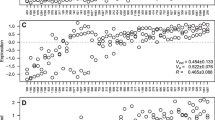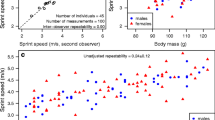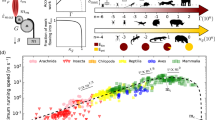Abstract
Various aspects of performance (e.g., speed, strength, endurance) are thought to be important determinants of the success of animals in natural activities such as foraging, mating, and escaping from predators. However, it is generally known that morphological properties enhancing one type of performance (e.g., strength) can lead to a reduction in another (e.g., speed). Such performance trade-offs have been quantified at the inter-specific level, but evidence at the individual level remains equivocal. To test for the presence of a performance trade-off, we repeatedly captured a total of 189 wild white-footed mice (Peromyscus leucopus) and measured their grip strength and sprint speed. Using the maximum performance score obtained for each individual across all their repeated tests, we obtained a counter-intuitive (and biased) positive and highly significant phenotypic correlation. Using a bivariate mixed model, we detected a significant negative among-individual correlation between grip strength and sprint speed. By contrast, the within-individual correlation was positive but non-significant, thus illustrating the importance of properly partitioning the correlations at the among- and within-individual levels when testing for the presence of a performance trade-off. This study is one of the first to detect a performance trade-off at the among-individual level in a wild animal population. Such a trade-off may be caused by individual differences in muscle physiology and scapular morphology resulting from genetic differences and/or plastic responses to differential use of the arboreal vs. terrestrial parts of the environment.




Similar content being viewed by others
References
Adolph SC, Hardin JS (2007) Estimating phenotypic correlations: correcting for bias due to intraindividual variability. Funct Ecol 21:178–184
Araya-Ajoy YG, Mathot KJ, Dingemanse NJ (2015) An approach to estimate short-term, long-term and reaction norm repeatability. Methods Ecol Evol 6:1462–1473
Barnum SA, Manville CJ, Tester JR, Carmen WJ (1992) Path selection by Peromyscus leucopus in the presence and absence of vegetative cover. J Mammal 73:797–801
Bartlett LJ, Wilfert L, Boots M (2018) A genotypic trade-off between constitutive resistance to viral infection and host growth rate. Evolution (N Y) 72:2749–2757
Bates D, Mächler M, Bolker B, Walker S (2014) Fitting linear mixed-effects models using lme4. J Stat Softw 67:1–48
Bendell JF (1959) Food as a control of a population of white-footed mice, Peromyscus leucopus noveboracensis (Fischer). Can J Zool 37:173–209
Bennett AF, Huey RB, John-Alder H (1984) Physiological correlates of natural activity and locomotor capacity in two species of lacertid lizards. J Comp Physiol B 154:113–118
Bolivar VJ (2009) Intrasession and intersession habituation in mice: from inbred strain variability to linkage analysis. Neurobiol Learn Mem 92:206–2014
Breheny P, Burchett W (2017) Visualization of regression models using visreg. R Package 9:1–15
Butler DG, Cullis BR, Gilmour AR, Gogel BJ (2009) ASReml—r reference manual. VSN International Ltd., Ashburton
Calder WA (1996) Size, function, and life history. Dover Publication, INC, Mineola
Calsbeek R, Careau V (2019) Survival of the fastest: the multivariate optimization of performance phenotypes. Med Sci Sport Exerc 51:330–337
Careau V, Garland TJ (2012) Performance, personality, and energetics: correlation, causation, and mechanism. Physiol Biochem Zool 85:543–571
Careau V, Wilson RS (2017a) Of uberfleas and krakens: detecting trade-offs using mixed models. Integr Comp Biol 57:362–371
Careau V, Wilson RS (2017b) Performance trade-offs and ageing in the “world’s greatest athletes”. Proc R Soc B Biol Sci 284:20171048
Careau V, Killen SS, Metcalfe NB (2014) Adding fuel to the “fire of life”: Energy budgets across levels of variation in ectotherms and endotherms. In: Martin LB, Ghalambor CK, Woods HA (eds) Integrative organismal biology. Wiley Scientific, New York, pp 219–233
Charters JE, Heiniger J, Clemente CJ, Cameron SF, Amir AF, Nasir A, Niehaus AC, Wilson RS (2018) Multidimensional analyses of physical performance reveal a size-dependent trade-off between suites of traits. Funct Ecol 32:1541–1553
Collins HH (1923) Studies of the pelage phases and of the nature of color variations in mice of the genus Peromyscus. J Exp Zool 38:45–107
Dingemanse NJ, Dochtermann NA (2013) Quantifying individual variation in behaviour: mixed-effect modelling approaches. J Anim Ecol 82:39–54
Djawdan M, Garland TJ (1988) Maximal running speeds of bipedal and quadrupedal rodents. Am Soc Mammal 69:765–772
Dohm MR, Hayes JP, Garland TJ (1996) Quantitative genetics of sprint running speed and swimming endurance in laboratory house mice (Mus domesticus). Evolution (N Y) 50:1688–1701
Eaton RL (1974) The cheetah: the biology, ecology, and behaviour of an endangered species. ecology. Van Nostrand Reinhold Company, New York, pp 41–87
Feder ME, Bennett AF, Huey RB (2000) Evolutionary physiology. Annu Rev Ecol Syst 31:315–341
Fitzgerald VJ, Wolff JO (1988) Behavioral responses of escaping Peromyscus leucopus to wet and dry substrata. J Mammal 69:825–828
Freeman PW, Lemen CA (2008) A simple morphological predictor of bite force in rodents. J Zool 275:418–422
Friedman WA, Garland TJ, Dohm MR (1992) Individual variation in locomotor behavior and maximal oxygen consumption in mice. Physiol Behav 52:97–104
Garland TJ (1983) The relation between maximal running speed and body mass in terrestrial mammals. Zool Soc Lond 199:157–170
Garland TJ, Carter PA (1994) Evolutionary physiology. Annu Rev Physiol 56:579–621
Garland TJ, Losos JB (1994) Ecological morphology of locomotor performance in squamate reptiles. In: Wainwright PC, Reilly S (eds) Ecological morphology: integrative organismal biology. University of Chicago Press, Chicago, pp 240–302
Garland TJ, Else PL, Hulbert AJ, Tap P (1987) Effects of endurance training and captivity on activity metabolism of lizards. Am J Physiol Regul Integr Comp Physiol 252:R450–R456
Graves S, Maldonado J, Wolff JO (1988) Use of ground and arboreal microhabitats by Peromyscus leucopus and Peromyscus maniculatus. Can J Zool 66:277–278
Green DJ, Richmond BG, Miran SL (2012) Mouse shoulder morphology responds to locomotor activity and the kinematic differences of climbing and running. J Exp Zool Part B Mol Dev Evol 318:621–638
Harney BA, Dueser RD (1987) Vertical stratification of activity of two Peromyscus species: an experimental analysis. Ecology 68:1084–1091
Head AW, Hardin JS, Adolph SC (2012) Methods for estimating peak physiological performance and correlating performance measures. Environ Ecol Stat 19:127–137
Herrel A, Bonneaud C (2012) Trade-offs between burst performance and maximal exertion capacity in a wild amphibian, Xenopus tropicalis. J Exp Biol 215:3106–3111
Huey RB, Dunham AE, Overall KL, Newman RA (1990) Variation in locomotor performance in demographically known populations of the lizard Sceloporus merriami. Physiol Zool 63:845–872
Husak JF, Fox SF, Lovern MB, Van Den Bussche RA (2006) Faster lizards sire more offspring: sexual selection on whole-animal performance. Evolution (N Y) 60:2122
Jayne BC, Bennett AF (1990) Scaling of speed and endurance in garter snakes: a comparison of cross-sectional and longitudinal allometries. J Zool 220:257–277
Karlsson J, Sjödin B, Jacobs I, Kaiser P (1981) Relevance of muscle fibre type to fatigue in short intense and prolonged exercise in man. Ciba Found Symp 82:59–74
Kormi-Nouri R, Nilsson LG, Ohta N (2005) The novelty effect: support for the novelty-encoding hypothesis. Scand J Psychol 46:133–143
Korytko AI, Vessey SH (1991) Agonistic and spacing behaviour in white-footed mice, Peromyscus leucopus. Anim Behav 42:913–919
Lailvaux SP, Husak JF (2014) The life history of whole-organism performance. Q. Rev. Biol. 89:285–318
Lailvaux SP, Cespedes AM, Houslay TM (2019) Conflict, compensation, and plasticity: sex-specific, individual-level trade-offs in green anole (Anolis carolinensis) performance. J Exp Zool Part A Ecol Integr Physiol 331:280–289
Lappin AK, Husak JF (2005) Weapon performance, not size, determines mating success and potential reproductive output in the collared lizard (Crotaphytus collaris). Am Nat 166:426–436
Le Galliard JF, Ferrière R (2008) Evolution of maximal endurance capacity: natural and sexual selection across age classes in a lizard. Evol Ecol Res 10:157–176
Madison DM, Hill JP, Gleason PE (1984) Seasonality in the nesting behavior of Peromyscus leucopus. Am Midl Nat 112:201–204
Márquez R, Cejudo D (2000) Defensive behavior as an escape strategy in four species of Gallotia (Sauria, Lacertidae) from the Canary Islands (Spain). Copeia 2000:601–605
Menzel MA, Carter TC, Jablonowski LR, Laerm J (2000) The effect of time of release on microhabitat use by the white-footed mouse. Acta Theriol (Warsz) 45:167–173
Metzgar LH (1973) Exploratory and feeding home ranges in Peromyscus. J Mammal 54:760–763
Nakagawa S, Schielzeth H (2010) Repeatability for Gaussian and non-Gaussian data: a practical guide for biologists. Biol Rev 85:935–956
Nicholson AJ (1941) The homes and social habits of the wood-mouse (Peromyscus leucopus noveboracensis) in southern Michigan. Am Midl Nat 25:196–223
O’Steen S, Eby SL, Bunce JA (2010) Dynamically honest displays: courtship locomotor performance indicates survival in guppies. Funct Ecol 24:1045–1053
Oufiero CE, Walsh MR, Reznick DN, Garland TJ (2011) Swimming performance trade-offs across a gradient in community composition in Trinidadian killifish (Rivulus hartii). Ecology 92:170–179
Rabey KN, Green DJ, Taylor AB, Begun DR, Richmond BG, McFarlin SC (2015) Locomotor activity influences muscle architecture and bone growth but not muscle attachment site morphology. J Hum Evol 78:91–102
Reznick D, Nunney L, Tessier A (2000) Big houses, big cars, superfleas and the costs of reproduction. Trends Ecol Evol 15:421–425
Roff DA, Fairbairn DJ (2007) The evolution of trade-offs: where are we? J Evol Biol 20:433–447
Sardell RJ, Arcese P, Keller LF, Reid JM (2011) Sex-specific differential survival of extra-pair and within-pair offspring in song sparrows, Melospiza melodia. Proc R Soc B Biol Sci 278:3251–3259
Schaller GB (1972) The Serengeti lion. University of Chicago Press, Chicago
Schielzeth H (2010) Simple means to improve the interpretability of regression coefficients. Methods Ecol Evol 1:103–113
Schug MD, Vessey SH, Korytko AI (1991) Longevity and survival in a population of white-footed mice (Peromyscus leucopus). J Mammal 72:360–366
Sneddon LU, Huntingford FA, Taylor AC, Orr JF, Sneddon LU, Huntingford FA, Taylor AC (2000) Weapon strength and competitive success in the fights of shore crabs (Carcinus maenas). J Zool 250:397–403
Stephens PR, Wiens JJ (2008) Testing for evolutionary trade-offs in a phylogenetic context: ecological diversification and evolution of locomotor performance in emydid turtles. J Evol Biol 21:77–87
Van Damme R, Wilson RS, Vanhooydonck B, Aerts P (2002) Performance constraints in decathletes. Nature 415:755
van Noordwijk AJ, de Jong G (1986) Acquisition and allocation of resources: their influence on variation in life history tactics. Am Nat 128:611–624
Vanhooydonck B, Van Damme R, Aerts P (2001) Speed and stamina trade-off in lacertid lizards. Evolution (N Y) 55:1040–1048
Walker JA, Caddigan SP (2015) Performance trade-offs and individual quality in decathletes. J Exp Biol 218:3647–3657
Wilson RS, James RS (2004) Constraints on muscular performance: trade-offs between power output and fatigue resistance. Proc R Soc B Biol Sci 271:S222–S225
Wilson AJ, Nussey DH (2010) What is individual quality? An evolutionary perspective. Trends Ecol Evol 25:207–214
Wilson RS, James RS, Van Damme R (2002) Trade-offs between speed and endurance in the frog Xenopus laevis: a multi-level approach. J Exp Biol 205:1145–1152
Wilson RS, Niehaus AC, David G, Hunter A, Smith M (2014) Does individual quality mask the detection of performance trade-offs? A test using analyses of human physical performance. J Exp Biol 217:545–551
Wolak ME (2012) nadiv: an R package to create relatedness matrices for estimating non-additive genetic variances in animal models. Methods Ecol Evol 3:792–796
Wolff JO (1985) The effects of density, food, and interspecific interference on home range size in Peromyscus leucopus and Peromyscus maniculatus. Can J Zool 63:2657
Xia X, Millar JS (1991) Genetic evidence of promiscuity in Peromyscus leucopus. Behav Ecol Sociobiol 28:171–178
Zablocki-Thomas PB, Herrel A, Hardy I, Rabardel L, Perret M, Aujard F, Pouydebat E (2018) Personality and performance are affected by age and early life parameters in a small primate. Ecol Evol 8:4598–4605
Acknowledgements
We thank all field assistants who helped collect the data (S. Newar, H. Panique, and J. Veitch). We also thank two reviewers for their insightful comments.
Funding
This research was supported by funds from the Natural Sciences and Engineering Research Council of Canada (NSERC) (Grant no. 2016-04418) and Canada Research Chair programs.
Author information
Authors and Affiliations
Contributions
VC conceived the ideas and designed methods; IB collected the data; IB and VC analysed the data; IB led the writing of the manuscript with help from VC.
Corresponding author
Additional information
Communicated by Jean-François Le Galliard.
This article deserves to be honoured as a Highlighted Student Paper because it clearly shows how studying trade-offs requires the partitioning of trait (co)variances. We know performance trade-offs exist, yet they are rarely detected. This article shows why performance trade-offs have been rarely detected in past studies, mainly due to the use of “personal best” values and a focus on controlling for individual “quality” instead of properly partition trait (co)variances at the among- vs within-individual levels.
Electronic supplementary material
Below is the link to the electronic supplementary material.
Rights and permissions
About this article
Cite this article
Berberi, I., Careau, V. Performance trade-offs in wild mice. Oecologia 191, 11–23 (2019). https://doi.org/10.1007/s00442-019-04450-9
Received:
Accepted:
Published:
Issue Date:
DOI: https://doi.org/10.1007/s00442-019-04450-9




